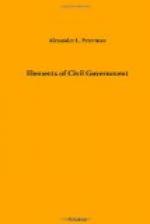Each party also has a State committee in each State, usually consisting of a member from each congressional district, in some States consisting of a member from each county; a district committee in each congressional, judicial, senatorial, and representative district, consisting of a member from each county composing the district; a county committee, consisting of a member from each township or civil district; and in some States, various other committees.
Each of these committees performs for the division for which it is selected duties similar to those which the national committee performs for the whole Union.
CONVENTIONS.—The method of ascertaining the choice of a party in the selection of candidates is either by a primary election or by a convention.
A political convention is an assemblage of the voters of a party, either in person or by representatives called delegates. If the voters assemble in person, the convention is called a primary or mass meeting.
The purpose of a convention may be to select candidates for office, to send delegates to a higher convention, to adopt a declaration of principles, or to decide upon a party policy. It is common for two or more of these purposes to come before the same convention.
CALLING CONVENTIONS.—In the year of the presidential election, the national committee calls a national convention, naming the time and place, and the representation of each State. The State committee calls a State convention to send delegates to the national convention; and, if a State election is approaching, it may direct that the convention shall also select candidates for State offices. In response to this call, the county committees order county conventions in all the counties of the State to send delegates to the State convention, and perhaps to select candidates for county offices. In some States the township committees order township conventions in all townships for the purpose of sending delegates to the county conventions, and perhaps to name candidates for township offices.
It will be seen that the calling of the various conventions connected directly or indirectly with the selection of candidates for President and Vice President proceeds from the highest downward. The same order is observed in other conventions, the call always beginning with the highest committee concerned and proceeding to the lowest.
LOCAL AND STATE CONVENTIONS.—The order of holding a system of conventions, however, proceeds from the lowest to the highest. The township holds a convention and sends delegates to the county convention. The county convention sends delegates to the State convention, and the State convention sends delegates to the national convention.
DELEGATES CHOSEN BY PRIMARIES.—In many states the delegates to all conventions are elected by the members of the party at primary elections. In some states even the delegates to the national convention are chosen in this manner.




